Back to Derry: An Oral History of 'Stephen King's It'
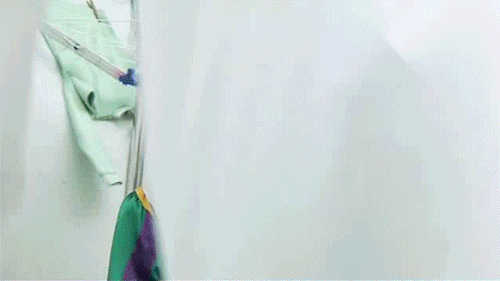
On a dark and chilly November evening in 1990, millions of viewers — both old and (in my case) young — switched on the television and beheld the true face of evil…and it wore clown make-up. That face belonged to Pennywise, the monster at the dark heart of Stephen King’s epic 1986 novel, It, soon to enter its third decade as required reading for horror-loving tweens and teens. But you don’t have to read the book to be freaked out by the two-part, three-hour TV movie that premiered on ABC on Nov. 18 and 20.
Twenty-five years later, Stephen King’s It still has the power to push its way into your slumbering mind in the dead of night, filling it with nightmarish visions of fortune cookies stuffed with eyeballs, balloons filled with blood and clowns with razor-sharp teeth. Tim Curry portrayed the grinning, gruesome Pennywise, and it’s a character (as well as a performance) that has long since entered the Horror Hall of Fame, while also dealing the clown industry a blow they’re still trying to recover from. But there’s more to It than great scares; the film is also a lovely portrait of childhood hopes and fears — with more than a few overtures to the beloved King-based film Stand By Me — and the memories we carry with us into adulthood. To celebrate It’s 25th anniversary, Yahoo TV spoke with some of the key individuals who brought King’s novel to life and created a movie that continues to haunt our nightmares and dreamscapes.
The Participants (In Alphabetical Order)
Dennis Christopher (Eddie Kaspbrak)
Larry Cohen (Screenwriter)
Stephen King (Author)
Bart Mixon (Special Makeup Effects Supervisor)
Annette O’Toole (Beverly Marsh)
Emily Perkins (Young Beverly Marsh)
Tim Reid (Mike Hanlon)
Marlon Taylor (Young Mike Hanlon)
Tommy Lee Wallace (Director)
Gene Warren Jr. (Special Visual Effects Supervisor)
It Begins
Originally published in 1986, It held the distinction of being Stephen King’s longest novel at the time, weighing in at 1,138 pages. (The unabridged version of The Stand later surpassed it by 14 pages. Under the Dome is a close third at a page count of 1,074.) Within that sprawling text, King recounts the story of seven children from the small town of Derry, Maine, whose lives are forever changed by a run-in with a powerful creature that adopts many faces and forms, most notably the clown-faced boogeyman, Pennywise. While they survive that initial childhood encounter, decades later Pennywise resumes his killing ways, forcing the now-grown members of the so-called “Losers Club” to return home and confront their fears. ABC quickly acquired the rights for what would be King’s first made-for-TV film since Salem’s Lot in 1979, and offered the monumental task of adapting the book to Larry Cohen, who previously penned the 1976 feature film version of Carrie that became an instant horror classic.
Stephen King: I’ve always been interested in childhood. For awhile, I was the only guy around [in the horror genre] who wanted to write about children and grown-ups. William Golding wrote an introduction to his book, Lord of the Flies, where he talks about the genesis of that story. He was sitting with this wife by the fire one night, and he said to her, “What would you think if I wrote a book about boys, but instead of writing a book about the way grown-ups like to remember boyhood, I write about how boys really are?” She said, “That’s a fantastic idea.” So he wrote Lord of the Flies, which is a book about children for grown-ups. I thought to myself that I’d really like to write a story about what’s lost and what’s gained when you grow up from childhood to adulthood, and also, the things we experience in childhood that are like seeds that blossom later on.
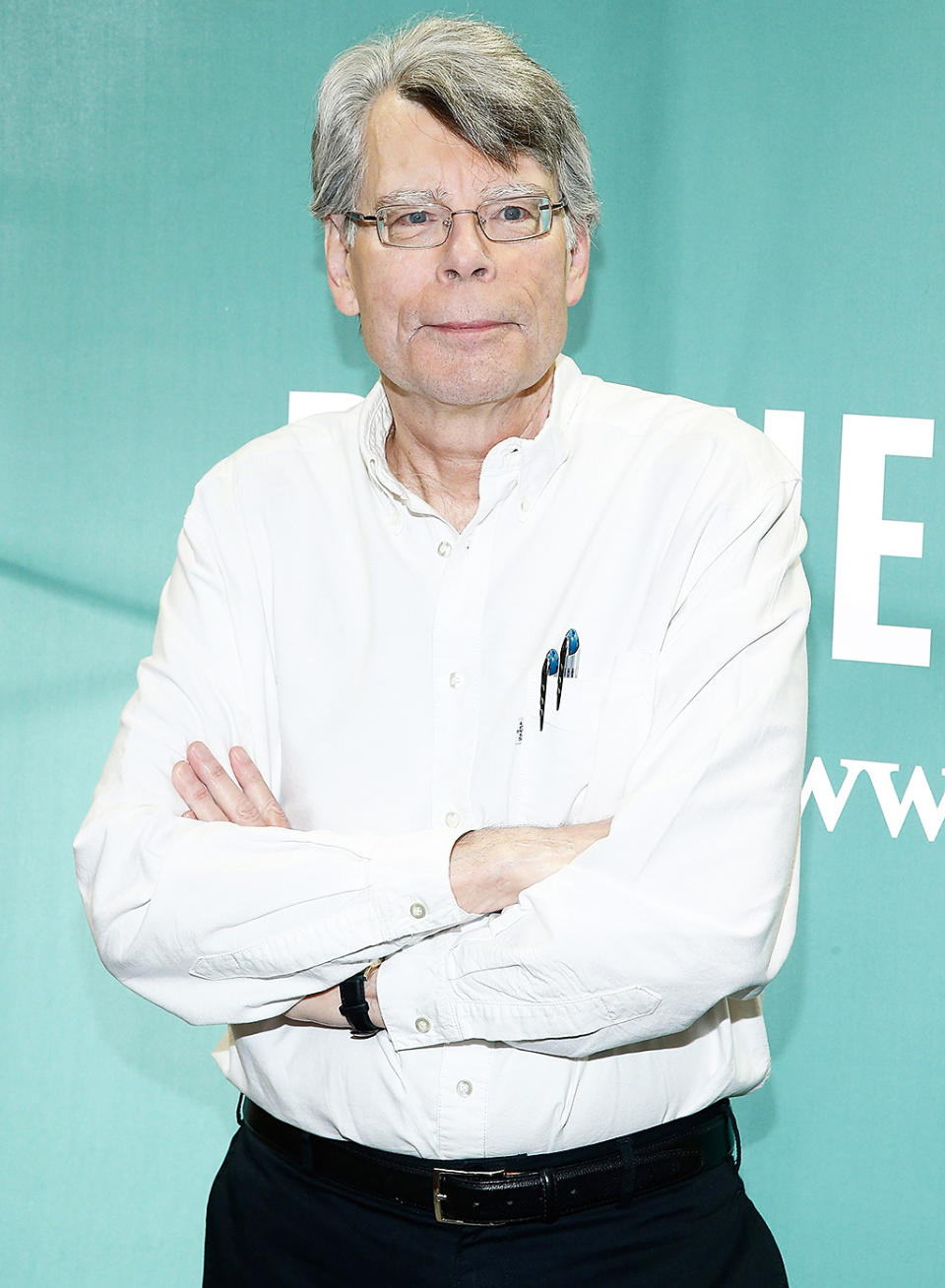
Author and America’s Favorite Boogeyman, Stephen King
Larry Cohen: It’s 1986, and the phone rings in my New York apartment. My agent’s voice on the other end says, “How would you like to do a Stephen King adaptation for ABC?” I pressed him for more details, and he told me, “It’s called It, and it hasn’t been published yet. Oh, and one more thing: it’s long. Very long.” The next day, the Fed Ex delivery guy rang the doorbell, and I opened it to find him struggling with the single largest Fed Ex container I’d ever seen. I took the box from him, and he said, “Hang on; there’s another one.” My initial thought was that they sent me two copies by mistake, but no, inside was the typed manuscript for It — all 1,100 pages. Compared to Carrie, which is a tiny little slip of a novel, It had the doorstopper heft of an epic, and was chockablock with incident, characters and indelible scares. I cleared off my desk, dove in and after 100 pages, I called my agent back and said, “Yes, I’d love to do this.”
King: I was hands-off in the making of It, basically saying, “Hope you guys do a good job; I wish you well.” These days, I have a lot more input into film and television adaptations of my work, in the sense that I can greenlight cast members or screenwriters or directors. Back then, I’m not so sure that I did. And even if I had, I probably still would have decided to be hands-off.
Cohen: Steve was pretty much radio silent throughout the process. A couple of factors to keep in mind: first, he felt comfortable with me. We became friends during the making of Carrie, so I think he felt that It would come out well, too. He also had the opportunity to read the various drafts of the script as I finished them. Secondly, he was comfortable about it being a novel for television. This was the heyday of networks adapting lengthy novels for TV, and initially It was going to be an eight-to-ten hour series. Thirdly, the producers brought George A. Romero onboard to direct. He and Steve had worked together on Creepshow, and I was beyond ecstatic as a huge fan of Night of the Living Dead. It was going to be the horror miniseries to end all horror miniseries. Of course, life doesn’t always work out the way it appears that it’s going to at the time.
Bart Mixon: The first draft of the script I read was a three-parter that would have been six hours. Then it was cut down to four hours.
Tommy Lee Wallace: As of my signing [to direct], the plan was a two-night miniseries. But the project had a long history before I came aboard, so God knows what might have been planned or discussed before my tenure.
Cohen: Speaking candidly, ABC was always nervous about It, primarily the fact that it was in the horror genre, but also the eight-to-ten hour commitment. They loved the piece, but lost their nerve in terms of how many hours they were willing to commit. Eventually, they were agreed to a two-night, four-hour commitment and at that point, a couple of things happened. George dropped out, primarily because he had a scheduling conflict, but truthfully I think getting only four hours instead of eight took the magic out of the project for him. And then the original producers left — while still retaining their producer credits — and another set came aboard, and the production moved to Vancouver. At the point that we met with Tommy to direct the series, we were at four hours.
Wallace: I had not read the book, so when I sat down with the script, I didn’t know what to expect. After reading the first part, I got very excited, told my agent “Yes,” and met with the producers and Larry, and was hired soon afterward. Things were great at first: Larry’s script for Night 1 was just wonderful, well organized and cleverly structured into seven parts for seven characters. His script for Night 2 wasn’t nearly as successful, in my opinion. For reasons of his own, he had completely moved away from the plotting of the book, and created a much smaller story, a very interior melodrama focusing on Beverly’s husband as the ultimate bad guy, or something to that effect. I wasn’t happy with it at all, but Larry didn’t show much enthusiasm for a big rewrite. I asked him to come to Vancouver and work with me on the script for Night 2, but he declined. With little other choice, I turned to the best writer I could get for no money — myself. The rewrite better reflected the basic plot of the book, or as much as a radical condensation would allow.
Cohen: Tommy asked me to do the rewrite of Night 2, but at that point, I had other film projects that I was steaming ahead on. And, for me, some of the excitement had gone out of It. It wasn’t that I didn’t think it could be successful at four hours, it was that I felt it would be more conventional as a result. There were so many hard decisions about what to cut out that we made along that way, that the prospect of excising more was difficult. So I said, “Thank you very much, but no thanks.”
Wallace: It became evident that ABC was fully behind the show when we started going after well-known TV stars like John Ritter and Harry Anderson, and getting them. Most of the adult casting was “telephone” casting, which is, “No need to audition so-and-so for the role, they’d be brilliant.“ Casting the kids came after casting the adults. We definitely wanted as much of a physical resemblance as we could, and I think we really got that in almost every case. We cast Jonathan Brandis and Seth Green from Los Angeles; most of the others came from Canada. Jonathan was a mini-coup; we were content with unknowns, and suddenly here was this unusual boy, a terrific actor and something of a child star in his own right.
Dennis Christopher: I hadn’t read the book before I got the part of Eddie; I don’t know if you’ve ever seen the hardback edition of It, but you could kill somebody with it! The thing that made me laugh was my characters nickname was “Eddie Spaghetti.” My brother’s name is Eddie and we called him “Eddie Spaghetti” growing up, so it was great to be carrying his moniker around with me into this.
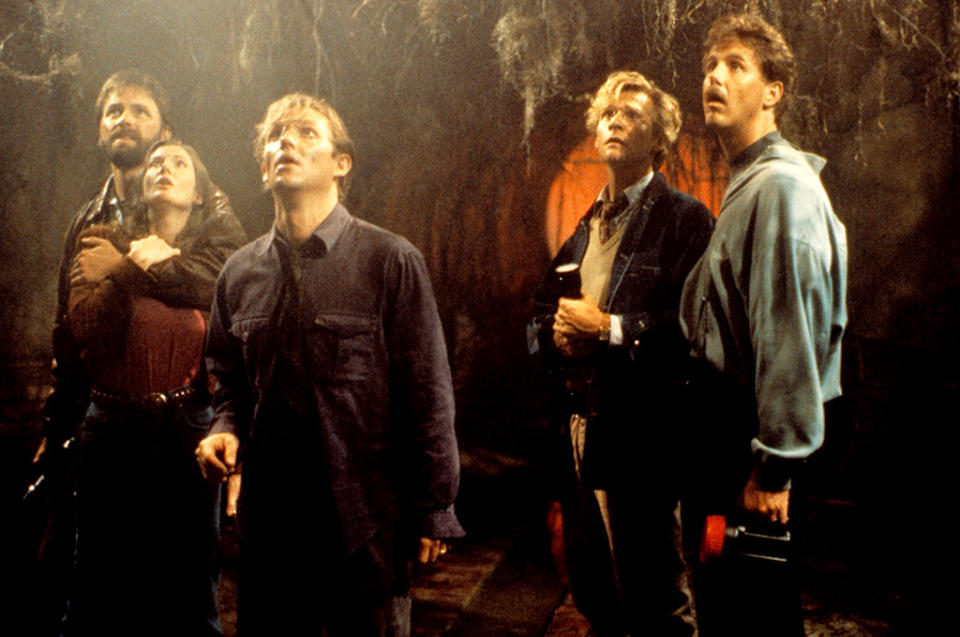
It adult cast: (from left to right) John Ritter, Annette O’Toole, Richard Thomas, Dennis Christopher, Harry Anderson
Annette O’Toole: I’d just done a TV movie with John Ritter, The Dreamer of Oz, and we had come in for a looping session when I asked what he was doing next. He told me about It and I said it sounded awesome. He looked at me and said, “They haven’t cast the girl yet.” I think he may have talked to somebody, because I got an offer [to play Beverly]. It happened really fast; I don’t think I even went in for a reading. I was living in Oregon at the time, and the next I think I knew, I was in Vancouver hanging out with the coolest, most fun guys of all time.
Tim Reid: The role of Mike came to me as an offer. I made a point of reading the book after I got the gig, because the script was an ongoing project until we got to the set.
Marlon Taylor: I went through two auditions and three or four callbacks before I was told that I had the part of young Mike. I hadn’t read It, but The Shining was one of my favorite movies at that point. I had three weeks of school left when we drove up to Canada to start filming, so I had about three weeks of homework with me in the car.
Emily Perkins: I was only 13 at the time I auditioned to play young Beverly, so I hadn’t read the book. But I’d already done a movie that was [a little scary], based on a true story about a mom who shot her kids. I thought it was fun having corn syrup put on me [as] fake blood; it was like Halloween. As a kid, I was always sensitive to the dark side of humanity and was sort of looking for undercurrents of tension and stuff. I think the reason that I do so well in auditions for horror films is that when I have to pretend that I’m scared, I really am scared.
Pennywise Takes Shape
From the beginning, it was clear that much of the success of the series rested on the casting and design of its main monster, Pennywise. Several different actors were considered until Tim Curry — best known for broadly comic turns in movies like The Rocky Horror Picture Show and Clue — became the unlikely choice for King’s macabre clown. But Curry proved an inspired piece of casting; aided by Bart Mixon’s make-up design, the actor (who suffered a stroke in 2012) radiated menace and fear from his very first appearance. For an entire generation of kids, Pennywise is the clown of their nightmares come to vivid, horrifying life.
Cohen: Pennywise is one of Steve’s great villains, and a part of the series I still take pleasure in 25 years later. I didn’t have an actor in mind as I was writing the script. The genius of Tim Curry was his background with The Rocky Horror Picture Show. He wasn’t afraid to leave it all on the floor. He could be brilliantly comedic in one scene, and utterly terrifying in the next.
King: Obviously the piece of casting that worked the best in the show was Tim Curry as Pennywise. At the time, there was some doubt about it, because he hadn’t played a part like that before. You got to be pretty gutsy as an actor to say, “I’m going to put on clown makeup and play a villain.” And you’ve seen Pennywise’s influence echo through the years. On American Horror Story: Freak Show, there was a guy dressed up as a clown, and that character owes a lot to Pennywise.
Bart Mixon: Special effects make-up is often very actor-drive; it needs to fit the face you’re working with. At one point, the rumor was that the role was going to be played by either Tim Curry, Malcolm McDowell or Roddy McDowall. Any of those guys would have been a very good and very unique Pennywise, but I’m glad they went with Tim.

The men who would be Pennywise (and the one who was): Malcolm McDowell, Tim Curry and Roddy McDowall
Wallace: Roddy and Malcom may well have been considered for Pennywise before I came on board. Both are formidable talents, and, given the part, would undoubtedly have done something interesting. By 1990, I had already worked with Roddy on Fright Night Part 2. Thinking of him as Pennywise is fun, but I think his innate sweetness might’ve worked against him. Of course, he would’ve found a way into nastiness and evil — good actors do that. Malcom would’ve called on his inner Droog, and the result would’ve been menacing and colorful, no doubt. Tim Curry was always the name for me; honestly, it’s hard to think seriously of anyone else in the role, he is and was that good.
Mixon: Once I got Tim’s headshot, I did a tracing of and started making various design sketches. We also made a head cast and designed three clay sketches so we could see how the design would look in three dimensions. The basic inspiration was Lon Chaney’s Phantom of the Opera, stylized into a clown. We ended up doing three versions: one that was a little heavier, almost a hobo clown, one that was a little meaner, and the one you see in the show. Originally, we intended to have a prosthetic chin and cheekbones, but Tim wanted to wear as little prosthetics as possible. We did use a special kind of prosthetic make-up cream for the clown make-up, one that doesn’t rub off. I wanted Pennywise to be very stylized, almost like a living cartoon.
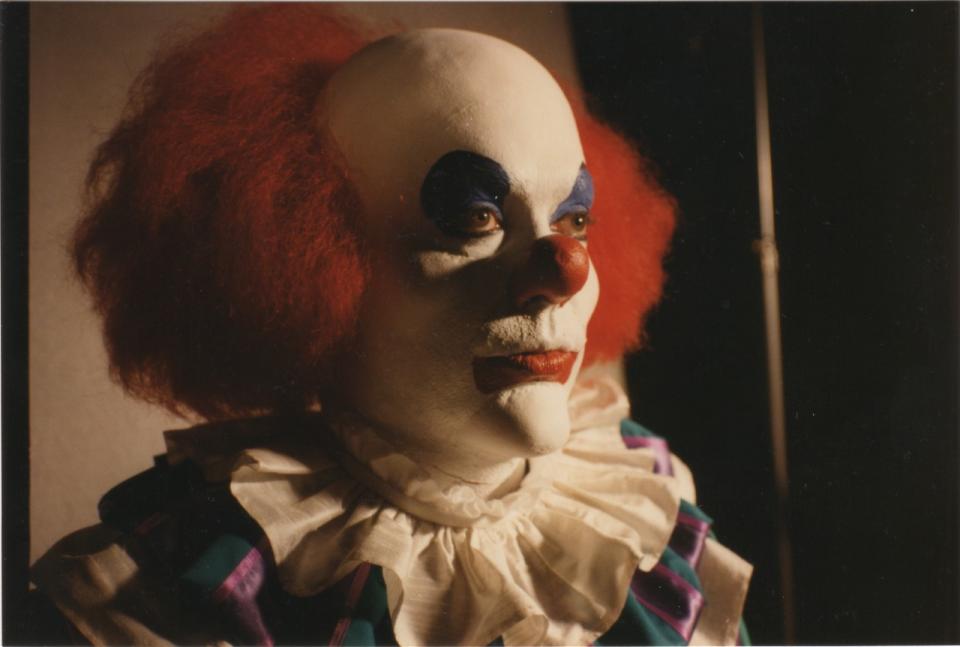
An early test version of Tim Curry’s Pennywise make-up, with cheek and chin appliances that were later abandoned. Photo courtesy of Bart Mixon.
Reid: Tim would be taken away, and then he’d come back in the make-up and would ask for our impressions. The looks kept becoming more and more dramatic, until someone said, “Why don’t you just use clown make-up and [false] teeth, not all the prosthetics?” When Tim came out as himself with just the clown make-up on, it was the most frightening thing. At that point, he really got into it and embraced the role in a way that was very intimidating. Clowns always bothered me as a kid. They’re like mimes. Mimes and clowns are not my favorite occupations.
Wallace: In pre-production, I did a lot of design work around clown makeup and costume with the storyboard artist, production designer, costumer and the makeup guys, including some pretty elaborate facial rubber, exaggerated cheekbones, a sharpened chin, and a bulbous forehead. Tim objected strongly to all the rubber. He had recently been in several movies which covered him in prosthetics and I’m sure he felt all the glue and latex would just get in his way. He was right, of course. With those eyes, and that mouth, and his crazy, sardonic sense of humor, less turned out to be more in the makeup department. I did insist on keeping the bulbous forehead, and I’m glad I added that much. It gave him a supernatural aspect without getting in the way.

Special Makeup Effects Supervisor Bart Mixon touches up Tim Curry for Pennywise’s “acid burn” look. Photo Courtesy of Bart Mixon.
Mixon: We had a few sets of teeth for Pennywise: a small set of sharp teeth that Tim could talk with, and a much bigger set that they only used for a couple of shock cuts. Tim could barely close his mouth with that set. The important thing was to make sure Pennywise looked like a friendly clown. This creature is trying to lure children in, so he’s not going to be a monster at first. He’s going to be enticing.
Perkins: Tim would sit in his chair chain-smoking in his make-up. Whenever the kid actors got too close, he would grin at us with his horribly pointed teeth. He really tried to intimidate us, because he wanted the fear to be real in our performances. He didn’t make any effort to be nice, at least not to me!

O’Toole: Tim was part of the adult gang. We all stayed in this cool apartment building by Stanley Park and had a lot of fun together. The poor guy had to spend a ton of time in make-up chairs. He knew the score, but it was crazy. We’d see him running back and forth from the set to his make-up trailer all the time.
Wallace: The movie, really, is only as good as its villain, and Tim carved out a place for himself as one of the great movie villains of all time. We had what I think of as an ideal relationship between a director and an actor: I cast the right guy in the part, and then tried not to get in his way while he did his magic. I only needed to steer a little here and there, which is an ideal situation for a director. Tim was always well-prepared, easy on set, patient and low-key; he saved his fireworks for when the camera was rolling.
Life During It
Filmed over two to three months on location in Vancouver, It proved a demanding shoot, as Wallace juggled two separate seven-person casts of children and adults, as well as the intensive labor of pre-CGI special effects. But the twin ensembles played hard in addition to working hard. Friendships and memories were made, and all involved speak highly of the two cast members who have since passed away: John Ritter and Jonathan Brandis.
Reid: We were in Vancouver for quite awhile, and we all became very close. It was like summer camp. We’d go out for dinner with each other, and were a rowdy crowd. It was not for the faint of heart to be hanging out with us.
Perkins: The kids hung out together when we weren’t shooting. I remember we went and saw Dick Tracy together in the theater. I thought the boys were very silly, whereas I thought of myself as very mature. They were always on their Game Boys when they were supposed to be rehearsing. I probably spent the most time with Brandon Crane, who played young Ben. He was a really nice, down to earth guy. Some of the others were more Hollywood kids. I remember that Seth Green was constantly cracking jokes and wanted to have the whole crew laughing. He seemed like a real professional at that point, whereas some of us were just regular kids.
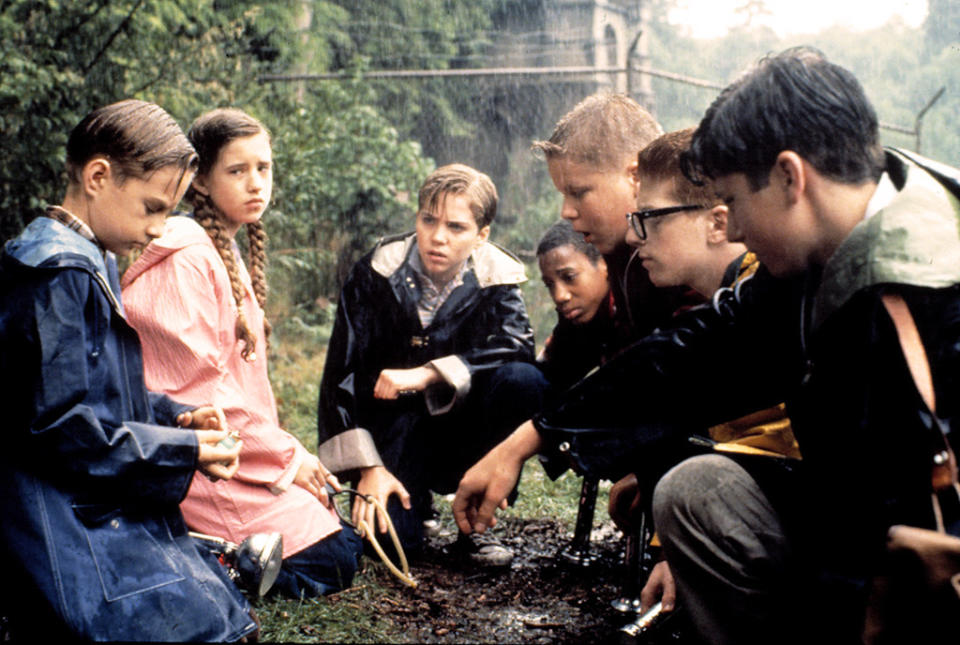
It child cast: (from left to right) Adam Faraizi, Emily Perkins, Jonathan Brandis, Marlon Taylor, Brandon Crane, Seth Green, Ben Heller
Taylor: We all stayed in the same hotel and had stipends while we were working on the series. So we’d go down to the hotel pool or go out and see Vancouver. I was a little bit closer to Seth than everybody else. He was the person I mainly hung out with in Canada and then we hung out a bit when we got back to L.A., before I went off to college.
Wallace: We made a point of bringing the adult and children actors together for a couple of days even though it was costly, since the adults and the kids have no scenes together. I felt strongly that it would be worth it, and it was. They paired up and provided each other with specifics as to key gestures and the like. Bill’s unique stutter and Stan’s ear pulling are the most obvious examples. But to a much deeper degree, I believe the group simply created a magical connection which is hard to quantify, but which showed up right there onscreen.
Perkins: I don’t remember having a lot of contact with Annette. If I had spent more time with her, I might have been able to pick up some of her mannerisms and stuff. I remember we had an acting coach who said that we didn’t really need to watch them and that we were similar looking enough that it would work to be playing the same character.
O’Toole: I met Emily and I remember that the kids were around a little bit. But our shooting schedules were so different, so there wasn’t a lot of time. Someone pointed out to me that she and I fire Beverly’s slingshot with different hands. For some reason, the left one was the one I pulled back with. That’s really supposed to be the aiming hand, so I did it backwards. It never occurred to me.
Wallace: John Ritter was everything you’d want in an actor, with no star games, and no vanity at all. Because he was such a comedy icon due to Three’s Company, he was always eager to display his "serious” acting chops, of which he had plenty. I’m a big believer in cross-casting, casting comics as villains, and dramatic actors in farces, so having him do drama, or melodrama, if you prefer, struck me as just right. Jonathan was unusually centered and focused for such a young man. He and I worked together a bit again, a few years later, on the TV movie, Born Free: A New Adventure. He had matured a bit, of course, but he seemed overly serious and distracted, as well. I recognize now that it may have been depression; wish I’d had better insight at the time, but it’s probably naive to think I could’ve helped him in some way. [Jonathan Brandis hung himself in 2003 at the age of 27.] A tragedy. As was John Ritter, whose life felt very much unfinished, even though he had a long and varied career.
Christopher: John kept us laughing all the time. He always broke the tension with a joke. He was very generous and love, and very, very funny. We recorded the commentary track for the DVD version of It two or three weeks before he passed away. It was great to be able to see him again.
Perkins: I had a huge crush on Jonathan Brandis. He was really cute, and a very nice kid. I remember John Ritter being very funny and really wanting to connect with the kids. Of all the adults, he was the one who really made an effort. I had grown up watching Three’s Company, so I was really starstruck when I met him. I remember him going, “Pull up a chair and come talk with me for awhile.” He was a very kind man.
Reid: When my kids came to visit me on set, they could have cared less about me — they only wanted to see John Ritter. It was like, “Move over, Dad. You’re blocking my view of John.”
Nightmare Fuel
As a primetime network production, It had stricter parameters than the gory horror films at the time or, for that matter, the equally gory cable TV series of today. Despite — or maybe because of — those limitations, the series still manages to be spectacularly scary, relying on the power of suggestion, tactile special effects and an atmosphere of creepy menace to unnerve viewers.
Mixon: ABC didn’t want It to be too gory. Like with the skeleton that young Ben sees by the lake, they kept saying, “Don’t make it wet!” I was like, “If the skeleton’s coming out of the water, it’s going to be wet.” They just didn’t want any [wet] gore, although rot and decay was okay. I was surprised that we got away with Stan’s severed head in the refrigerator, because if you look closely, you’ll see that there’s a cup of yogurt below with blood dripping into it. Nowadays, they’d have a lot more hamburger and stuff hanging out of the head.
Cohen: The cardinal rule of the Standards and Practices division of a network is not to show kids in jeopardy. Ironically, though, that’s the very basis of It. We found ways around that rule; for example, we couldn’t be explicit about, say, Georgie’s arm being yanked off by Pennywise, but we could talk about it. And we could do things that allowed viewers to fill in the blank with their imaginations. But there were still amazing amounts of real horror that got onscreen, like Pennywise cornering Eddie in the shower, and the fortune cookie scene. The sequence is so Stephen. He has that gift for taking something perfectly ordinary and turning it into a case where you’ll never be able to look at a fortune cookie in the same way again.
Reid: None of us were allowed to know what was going to happen in the fortune cookie scene. So our expressions were all real in the first take.

O’Toole: I remember that Harry’s fortune cookie had an eye inside it. And he said, “Oh man, it’s an eye!” I don’t know why, but it struck us as so hilarious at the time. We were all so slap-happy that day. So anytime during the rest of the shoot that Harry said, “Oh man, it’s an eye,” we would all just die laughing.
Wallace: The fortune cookie scene is an example of how to get great scare-power out of fairly humble, low-budget special effects. A trick table, puppeteers underneath, a handful of creepy little cookie models, a group of characters taken by surprise. So much depended on the details. True horror happens in the mind, when a horrific idea is planted, such as the half-developed embryo of a tiny bird, all wet, moving helplessly, right there in a fortune cookie you were about to eat! It’s revolting and insidious, and after jolting you, you’re left with this awful notion: What kind of sick f–k would come up with such a thing? The element of surprise plays a part; you’re invested in your characters, and they don’t see what’s coming, and suddenly you’re IN it, and IT’s GOT YOU, it’s all around you, and it’s f–king with your mind. It’s convincing, the angles are good, the cutting is rapid and unnerving, the imagery and music are creeping you out — oh boy, when everything’s clicking, it’s delicious.

King: I like the scene early on in the series where Georgie is looking into the storm drain and sees Pennywise. The drain has that frame around it, so you’re also seeing Georgie from the clown’s point of view. And then Tim says, “We float down here, we all float.”
Gene Warren: The shower scene with Pennywise where we comes out of the drain was done with replacement animation. It’s an animation technique you can use when you’re shooting effects single frame. We sculpted every frame one at a time, and the hole grew bigger and bigger. It’s very time consuming, and rarely done anymore except for stop motion movies. What’s good about it is that it looks like it’s really there, and not just 0s and 1s.
Perkins: We had to do multiple takes of my scene in the bathroom, when the balloon comes out of the drain. I was really focused on the mechanics of it. They had 10 pairs of pajamas with different amounts of blood spatter on them, and some clean ones in case they had to redo it. It was challenging, blowing up the balloon and having it explode at the right moment. And when you’re filming in a room with 60 people in it, it’s not really all that scary at all. In the next scene, Beverly goes and tells her dad that there was a spider in the sink. So during the bathroom sequence, I pretended that I did see a spider, because for me that would have been scarier than what I actually was seeing.

Losing It
The process of adapting King’s 1,138-page novel into a three-hour TV film meant that a wealth of material hit the cutting room floor before cameras even started rolling. Whole subplots were excised, entire characters erased and some of the best scares and surprises — most notably a major revelation involving Beverly — remained forever on the page.
Cohen: I can’t even begin to enumerate my favorite scenes from the book that we had to cut, because there are so many of them. I look at as a glass half full situation. There are scenes in both nights that were created by Steve on the page, and I’m delighted that they survived, like the fortune cookie scene and adult Beverly going to her childhood house. The way I see it, the best moments from the book made the cut and the rest are casualties of war.
Wallace: One scene springs to mind: A secondary bad-guy character, Patrick Hockstetter, allied with Henry Bowers, gets attacked in the woods by a bunch of fleshy leech-things that come flying out of an old refrigerator Patrick keeps there as his killing-box for small, helpless animals. The leeches suck his blood, and then “It,” seen as a waxlike half-formed man, comes and drags him away to some dark place and feeds on him. It would’ve been fun to shoot, as would have a number of other such scenes — the book is bursting with them. In the end, I didn’t miss the stuff I had to leave out. I was living vicariously and completely within the scope of the two scripts I had in hand. The bigger, broader, and especially the more cosmic stuff of the novel simply fell away, and I didn’t miss it at all.
King: One thing that’s not in the TV show that I like in the book is that the Derry library has an adult library and a children’s library and they’re connected by a glass tunnel. To me, that sort of summarizes everything about the changes we go through as we age from children to adults, and what we lose when we grow up. The children are able to lock onto Pennywise and they know what he’s up to, whereas adults have blocked them entirely in their minds.
O’Toole: I do wish they could have included the fact that young Beverly is the first lover of each of those guys. It’s a huge part of the bond between them, because it’s the greatest act of love she feels she can give to each one of them when they thought they were all going to die. I totally understand why it was cut, and I think you got the idea from the movie that they were all in love with her and she with them.
Perkins: I remember the boys getting together in one of their trailers to read the part about Beverly. They were like, “She doesn’t know!” And I said, “What are you talking about?” And they said, “We all have sex!” I remember feeling really embarrassed. They kind of sprang it on me just to watch my reaction.
Christopher: In the book, Eddie has a very complicated sex life, so Tommy and I tried to figure out a way to summarize his problems into a couple of sentences. We decided to make his character a virgin, and that’s what he confesses to at the end, before they fight the giant creature and Eddie dies. We laughed, because we ended up offering [It] a virgin sacrifice!
Reid: I think they did a good job with the book. These things have to take on a life of their own. The coming of age story was well told and the conflict for each character was vivid. To this day, the only thing I’m not pleased about is the spider…
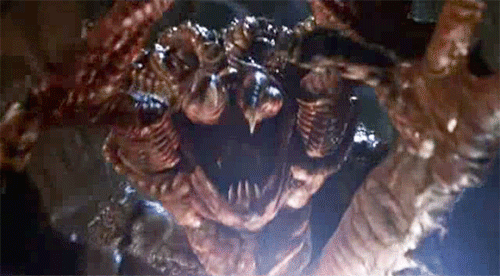
Spider Sense
Both the book and the film build to a climactic confrontation that pits the heroes against It in the form an enormous spider-like creature. It was a controversial ending on the page and an even more controversial ending onscreen, largely due to the technological limitations. Although the creature’s resemblance to various ‘50s-era Ray Harryhausen monsters makes thematic sense for the story, the prevailing opinion at the time and still today is that it’s one of the movie’s few false steps.
Mixon: My team built the spider I’m surprised by how much grief we got for it. In the book, the spider fights a turtle in outer space. So blame it on Stephen King! [Laughs]
Warren: Even in the book, I had a problem with the spider. King was able to conjure it up in his head, but it was difficult to bring to the screen. We set the tone and parameters in the first part of the movie with Pennywise. But when you get to the spider, you move into a different world. It was supposed to be a horror movie, not Jason and the Argonauts.
Mixon: In the original script, when the kids hit Pennywise in the head with a rock at the end of Night 1, there’s supposed to be hints of a spider in there. But it didn’t make sense to me for us to see a spider at that point in the story. So I suggested we just see the glowing “deadlights” instead. My idea for the actual spider is that it wasn’t supposed to be a real spider, it’s just the closest thing we can equate to IT. So our spider is spider-like, but weird and alien. It’s fleshier and meatier, and has a weird abdomen.
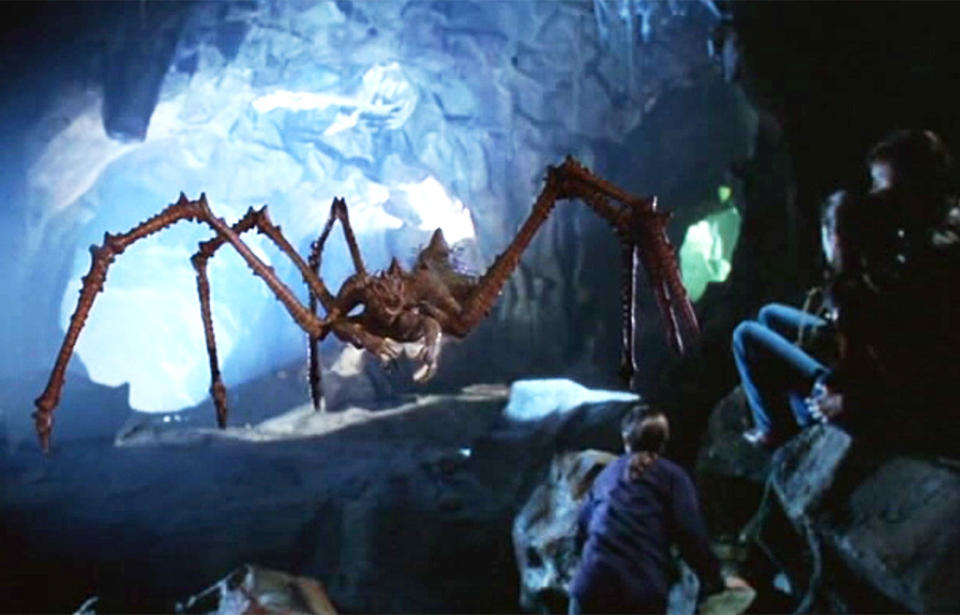
Wallace: We labored long and hard designing a spider that was very beefy and muscular, almost reptilian in appearance. It looked great in the drawings, and I even recall a little clay model Bart did, which sealed the deal and won my enthusiastic approval. Bart and team went back to Hollywood to work the whole thing up full-size, and shooting started. When the SVFX team returned to Vancouver and unpacked the full-size spider, what I expected to see was the big version of that original model, the beefy, reptilian thing that was scary on sight. What they assembled on set was very, very different. Not chunky at all, very lean and mean. That’s a pretty big change to have sprung on you a few hours before you’re supposed to shoot. I don’t mind saying that I was hugely upset, and considered scrapping the whole thing and starting from scratch — but there simply was no more time, and no more money. With advance notice, which absolutely should’ve happened, there might have been some other solution, but in this case, the show simply had to go on.
Mixon: We used a certain amount of animatronics for the head, and the body had some of my crew members inside it. Once we got it into place, we couldn’t move it around too much, because it was pretty unwieldy. For some reason, they shot it in super slow motion, so it’s no wonder it looks like it’s not moving! It was capable of more than what you saw onscreen. All my guys did great work on it, and I think it holds up nicely. I think Stephen King once referred to it as a “Tinker Toy” spider, but everyone’s entitled to their opinion.
Wallace: The other problem was one of simple color timing, believe it or not. The close-ups of the monster’s face were never supposed to be seen that clearly. When the show was timed, I was already on to a new gig, and the person who presided over the timing simply got it wrong. In the end, that’s my fault, not his, but it should never have gone out there with the audience being able to see the monster that clearly. That’s a major violation of monster rules, and I have regretted the mistake to this day.
O’Toole: The crew built an amazing set. It was fun to scramble up all those fake rocks. But it felt so different from the rest of the movie. I felt like we were suddenly in a standard horror film, like, “Okay, now we’ve got to run from the monster.” We called it the “Alaskan King Crab” monster.
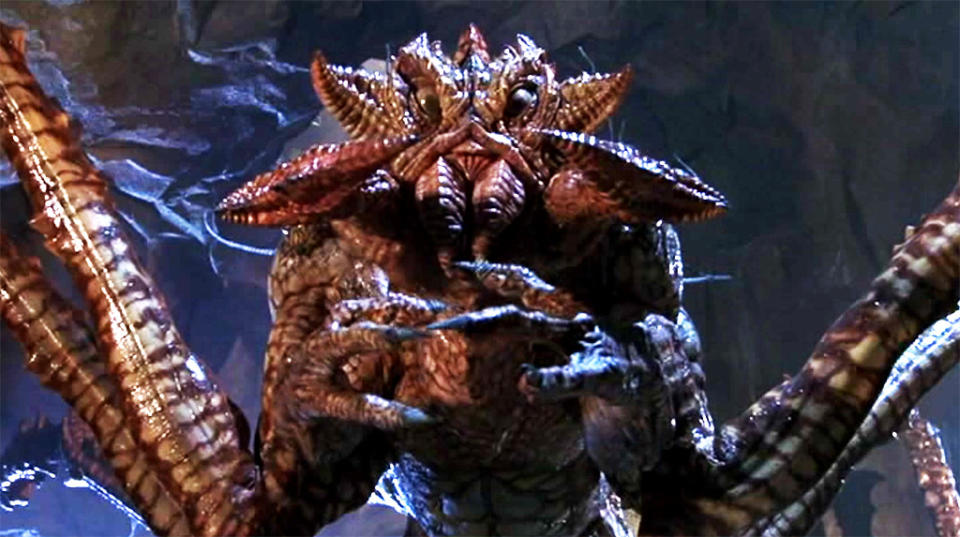
Reid: The emotional aspects of the story were what I liked most, the characters having to relive their childhood traumas as adults. It’s not just about a monster, it’s about the things we encounter in life that shape us. I didn’t think the spider was up to par with the rest of the story. I was like, “Get some Raid and spray it, and let’s move on.”
Mixon: I’ve got about six hours of behind-the-scenes video in my archives. There’s a scene of John Ritter working the radio that controlled some of the spider. He’s playing around with it and acting scared. It would be great bonus material on a special edition Blu-ray.
Christopher: That was the last scene we filmed, and I remember being impressed by how they were operating the spider. But I also wondered: Where the hell did the spider come from? It’s never really explained in the film. Is it Pennywise? Why did he embody a giant spider? So I had mixed feelings about it, but as actors, we went for it 150 percent. We all completely invested in what was in the script.
Cohen: In retrospect, we dodged one big bullet and lost the other battle, so to speak. The big bullet was the sequence of the boys losing their virginity to Beverly, which struck me as a no-go for all sorts of reasons. The more serious one was the ending Steve wrote. If I had to do it over again, my instinct would be to find a way to have the adults confront Pennywise in another way, in all his shapeshifting glory. Even today, with all the resources of CGI, I’m not sure that a spider would be the way to go. It doesn’t feel like an adult scare.
Wallace: I remember reading that passage in the book, and thinking, "Aww…really? A spider? "It” is just a big SPIDER?! So, maybe some of the letdown was built in from the get-go, no matter how good, bad or indifferent the spider special effects were. All that being said, I wasn’t stung by criticism of that specific scene. I knew it fell short, certainly by my own standards, but I also knew the show succeeded in general, and audiences invested in the story would cut us a little slack. As it turned out, they cut us a lot of slack. Even now fans come up and tell me how much It (including the big spider) scared them. I know the spider will never impress aficionados, but with the softer-core crowd, in context, seems like it went down fine.
The Legacy of It
One of the big success stories of the 1990 broadcast year, It kick-started a wave of King-based miniseries, movie and TV series from The Tommyknockers and Rose Red to Under the Dome and Hulu’s upcoming 11/22/63. And the film’s reputation has endured beyond its highly-rated television premiere. Twenty-five years later, It is frequently grouped amongst the all-time great King adaptations, a list that also includes The Shining, Stand by Me and The Shawshank Redemption. Despite various attempts to launch a big-screen remake — most recently by True Detective director, Cary Fukunaga, which fell apart earlier this year — this is the version of It that seems destined to keep scaring viewers for the next 25 years.
Cohen: At the end of the year, the head of Capital Cities, which owned ABC at the time, was interviewed and he said the best thing to happen [in 1990] was It because the ratings were insane. Something like 30 million people ended up watching the film over two nights. And then he said that the worst thing that happened was It because it wasn’t on every night! I think It helped them understand that the audience was there and hungry for an epic TV event. As a result, when it came time to make The Stand in 1994, ABC went for it and made a six-hour series. We were the leader in that regard. An eight-hour version of It would have been exactly like True Detective or these modern-day anthology shows. It would have provided the canvas to really get to know these characters.

Wallace: To this day, I haven’t met Stephen King in person. After finishing It, I wrote him a letter wondering about his reaction. He wrote me back a cordial and complimentary note. He shrugged off the controversies, and let me know how much he liked the show. Like me, he would have wished for more time and money for special effects and opticals, but overall he was very positive. Funnily enough, I haven’t so far gotten a clear shot at another King story. I think I might’ve done a good job with Firestarter. The movie missed its mark, somehow. Drew Barrymore was OK as the kid, but something about David Keith didn’t click, and poor George C. Scott was just about as miscast as you can get. Hearts in Atlantis was another one I would have enjoyed tackling.
Perkins: People see It as an important part of their childhood. I was at a fan convention, Hal-Con, recently and a lot of people wanted to talk about It with me, especially women who really loved Beverly and wanted to be her because they felt like an outcast, and saw her as a character with a lot of strength. Someone made this really beautiful cross-stitch of all the characters and Pennywise and asked me to sign it. That was really beautiful.
Thomas: They show It on FX quite a bit, so I get calls and texts from friends whenever its on TV. Or someone will find out that I was in it, and they’ll tell me the story of how Pennywise ruined their lives forever! I didn’t understand at the time how big a film it was going to be. It’s like A Clockwork Orange or something — a movie that’s going to be talked about for awhile.
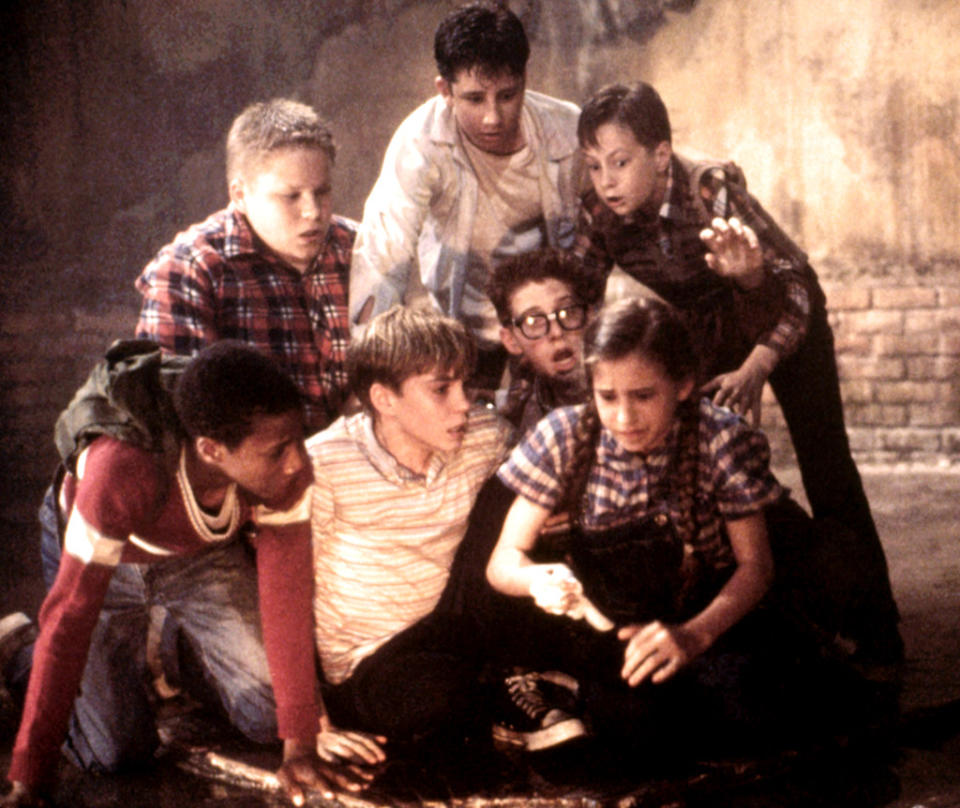
Mixon: It’s nice to have a signature character like Pennywise on your resume. I’ve done fan conventions in Mexico and Europe, and it’s a good feeling to hear people say nice things about him. I’m happy with my design, but it’s really Tim’s performance that sells it. I was actually contacted about working on the [Cary Fukunaga] remake, again doing the Pennywise make-up. I was about a week away from starting work, when they pulled the plug. If they try again, I hope they still use practical effects to create Pennywise. It’s an actor-driven role. I’d be curious to see him as a motion capture CGI character or something like that, but it would have to be really good CGI. It also all depends on who they cast. You don’t want a scary looking actor — it’s the performance that makes it intimidating.
O’Toole: It would be really hard to top Tim in the role of Pennywise. He’s so much scarier as that clown than any monster could ever be. And he’s the centerpiece of the film. I would tell whoever directs the remake to stick with the clown. You don’t need the Alaskan King Crab spider!
King: I saw a screen test of the guy [Will Poulter] they were going to cast as the new Pennywise, and he was f–king fantastic! Even without the makeup, he was going to absolutely kill it. They were very close going into the production, and I think it would have been terrific. Cary Fukunaga is a very talented man, but for whatever reason it didn’t work out. I think it came down to a paranoid decision [at the studio level] of, “We want to make a horror movie that will play off in a couple of weeks, but this guy wants to make a serious film.”
Wallace: To any director given that assignment, here’s my advice: Maintain clarity about the difference between “Scary” and “Gory.” Do all you can of the former, and not too much of the latter. Keep your eye on the ball: First and foremost, It is about an evil assault on a group of kids, and how they respond to this epic crisis. Don’t get lost in special effects, gimmicks ‘n’ gore, stunts and fancy camera work — it’s always gonna be about the people, and that’s what counts.
Reid: To be honest, I’m not a fan of remaking films. I think Hollywood has gotten lazy, and there are some things should be left alone. If it doesn’t happen, I think it’s for the better. There’s something about the simplicity of our version that would probably be lost. It would be more about technology, as opposed to being about people.
Christopher: Cary Fukunaga is really smart, instinctive guy. When I heard he’d be adapting It, I was quite excited because I felt his film might be a whole new interpretation, not just a remake. My only advice would be to concentrate on the relationships between the friends, which I think made It very accessible to a lot of viewers, because we all remember the band of kids we grew up with. People related to that, and because they did, we were able to smoothly introduce them to the supernatural side of the story as well. They believed in the friendship. My other advice would be that they should have all of us in the movie somehow!
Wallace: Since the success of It, I’ve been told many times that our show stands alongside Stand By Me as the best of the King adaptations. I regard that as high praise indeed. Everyone goes on about how “scary” Stephen King’s work is, and rightfully so, but what attracts me to him, and especially to It, is the epic saga of a group of kids who band together for comfort, solace, protection and courage, as well as certain rites and rituals of childhood friendship. To me, that’s the real secret of so much of Stephen King’s success, his ability to get inside the minds and hearts and secrets of children.
Cohen: Night 1 is as strong as it is because the kids are featured so prominently, and there’s some amazing magic with them, just as there is in Stand By Me. I could have happily watched the entire film with the kids and been really involved, moved and scared out of my mind. Steve think there’s magic in childhood and wrote an epic book that’s really a mediation on what it means to be a child and to grow up.
King: You have to remember, my expectations were in the basement. Here was a book that sprawled over 1,000 pages, and they were going to cram it into four hours, with commercials. But the series really surprised me by how good it was. It’s a really ambitious adaptation of a really long book. The kid actors were good, and the adult actors were terrific. There’s an earlier generation who remember watching Salem’s Lot on TV, and then there are the kids who remember seeing It. Get ‘em while they’re young, that’s my motto.
